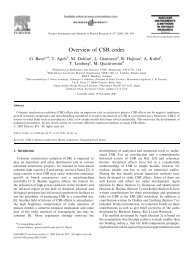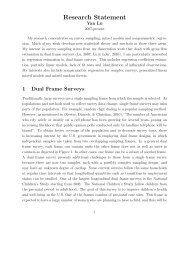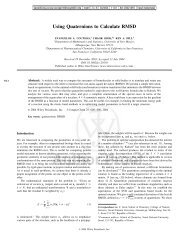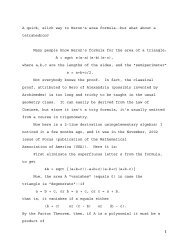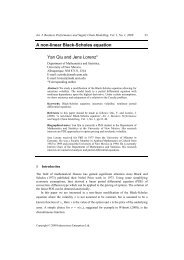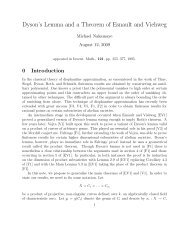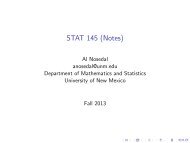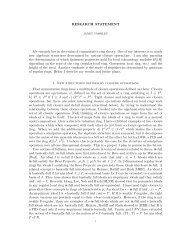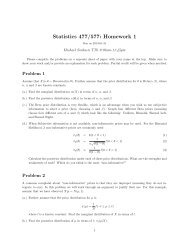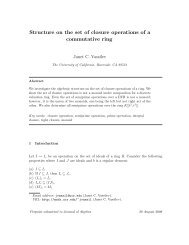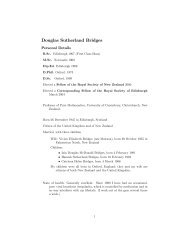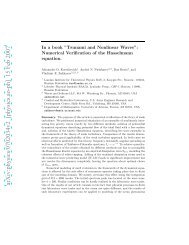OEO Office of Equal Opportunity - Department of Mathematics and ...
OEO Office of Equal Opportunity - Department of Mathematics and ...
OEO Office of Equal Opportunity - Department of Mathematics and ...
You also want an ePaper? Increase the reach of your titles
YUMPU automatically turns print PDFs into web optimized ePapers that Google loves.
180 ARTS AND SCIENCES<br />
analytical). All international students are required to submit<br />
their TOEFL scores.<br />
Economics (ECON)<br />
105. Introductory Macroeconomics. (3)<br />
Economics on a national scale: determination <strong>of</strong> national<br />
income, employment level, inflation <strong>and</strong> impact <strong>of</strong> policies<br />
affecting money supply, interest rates <strong>and</strong> government programs.<br />
Current macroeconomic issues <strong>and</strong> problems. Meets<br />
New Mexico Lower Division General Education Common Core<br />
Curriculum Area IV: Social/Behavioral Sciences (NMCCN<br />
2113). (Prerequisite for most upper-division courses).<br />
106. Introductory Microeconomics. (3)<br />
Exploration <strong>of</strong> individual consumer behavior, production<br />
decisions by the firm <strong>and</strong> supply <strong>and</strong> dem<strong>and</strong> relationships<br />
in the marketplace. Examination <strong>of</strong> the international dimension<br />
<strong>of</strong> production <strong>and</strong> consumption choices. Meets New<br />
Mexico Lower Division General Education Common Core<br />
Curriculum Area IV: Social/Behavioral Sciences (NMCCN<br />
2123). (Prerequisite for most upper division courses.)<br />
203. Society <strong>and</strong> the Environment. (3)<br />
(Also <strong>of</strong>fered as CRP 203.) Introduction to environmental<br />
<strong>and</strong> natural resource issues <strong>of</strong> both global <strong>and</strong> local scale.<br />
Investigates basic causes <strong>and</strong> consequences <strong>of</strong> environmental<br />
problems including interrelated physical <strong>and</strong> social<br />
science dimensions.<br />
212. Personal Investing. (3)<br />
Investment options available to the individual will be analyzed<br />
in terms <strong>of</strong> economic theories <strong>of</strong> capital markets. Risk, value,<br />
returns <strong>and</strong> portfolio analysis.<br />
239. Economics <strong>of</strong> Race <strong>and</strong> Gender. (3)<br />
Examines economic situation <strong>of</strong> women <strong>and</strong> minorities in the<br />
United States. Explores effects <strong>of</strong> race, gender <strong>and</strong> ethnicity<br />
on the economic performance <strong>of</strong> workers <strong>and</strong> evaluates various<br />
strategies for social change.<br />
**300. Intermediate Microeconomics I. (3)<br />
Intermediate analysis <strong>of</strong> microeconomic theory <strong>and</strong> concepts.<br />
Topics include consumer behavior <strong>and</strong> dem<strong>and</strong>, production<br />
<strong>and</strong> costs, price <strong>and</strong> output under both perfect competition<br />
<strong>and</strong> pure monopoly.<br />
Prerequisites: 105 <strong>and</strong> 106.<br />
**303. Intermediate Macroeconomics I. (3)<br />
Theories <strong>of</strong> national income determination in explaining<br />
business cycles; aggregate supply; <strong>and</strong> the role <strong>of</strong> expectations.<br />
Role <strong>of</strong> monetary <strong>and</strong> fiscal policies in stabilizing the<br />
economy.<br />
Prerequisites: 105 <strong>and</strong> 106.<br />
**309. Introductory Statistics <strong>and</strong> Econometrics. (3)<br />
Introductory statistics, probability, probability distributions <strong>and</strong><br />
hypothesis testing. Basic econometric techniques emphasizing<br />
estimation <strong>of</strong> economic relationships <strong>and</strong> the use <strong>of</strong><br />
econometric models in forecasting.<br />
Prerequisites: 105 <strong>and</strong> 106 <strong>and</strong> STAT 145.<br />
**315. Money <strong>and</strong> Banking. (3)<br />
Principles <strong>of</strong> money, credit <strong>and</strong> banking; organization <strong>and</strong><br />
operation <strong>of</strong> the banking system; <strong>and</strong> the relationship between<br />
money, banking <strong>and</strong> the level <strong>of</strong> economic activity.<br />
Prerequisites: 105 <strong>and</strong> 106.<br />
*320. Labor Economics. (3)<br />
Determinants <strong>of</strong> labor force, wage levels <strong>and</strong> structures,<br />
<strong>and</strong> employment; human capital theory <strong>and</strong> discrimination,<br />
economic consequences <strong>of</strong> trade union <strong>and</strong> government<br />
intervention.<br />
Prerequisites: 105 <strong>and</strong> 106.<br />
*321. Development Economics. (3)<br />
Theories <strong>of</strong> development <strong>and</strong> growth. Problems facing<br />
developing countries <strong>and</strong> possible solutions. Historical case<br />
studies <strong>of</strong> some developing countries.<br />
Prerequisites: 105 <strong>and</strong> 106.<br />
*330. Consumer Economics. (3)<br />
Introduces the theory <strong>of</strong> consumer behavior <strong>and</strong> dem<strong>and</strong><br />
analysis. Empirical applications <strong>of</strong> consumer theory will be<br />
explored. Possible topics include: consumer safety, family<br />
budgeting, marketing research <strong>and</strong> the household production<br />
function approach.<br />
Prerequisites: 105 <strong>and</strong> 106.<br />
*331. Economics <strong>of</strong> Poverty <strong>and</strong> Discrimination. (3)<br />
Explores trends in income distribution especially across <strong>and</strong><br />
within groups <strong>and</strong> examines theories explaining behavior <strong>and</strong><br />
outcomes. Public policy concerning poverty <strong>and</strong> discrimination<br />
is studied <strong>and</strong> discussed.<br />
Prerequisites: 105 <strong>and</strong> 106.<br />
*332. Economics <strong>of</strong> Regulation. (3)<br />
Nature <strong>of</strong> modern firms <strong>and</strong> markets: relationship <strong>of</strong> market<br />
structure, conduct <strong>and</strong> performance, including analysis <strong>of</strong><br />
antitrust policy, public utility regulation <strong>and</strong> “deregulation” <strong>of</strong><br />
some industries.<br />
Prerequisites: 105 <strong>and</strong> 106.<br />
*333. Industrial Organization. (3)<br />
Firms <strong>and</strong> markets; interactions <strong>of</strong> firms in markets that<br />
are noncompetitive (oligopolistic <strong>and</strong> monopolistic); various<br />
government policies to control the behavior <strong>of</strong> firms with<br />
market power.<br />
Prerequisites: 105 <strong>and</strong> 106.<br />
*335. Health Economics. (3)<br />
Market concepts <strong>and</strong> health care issues. Economic assessment<br />
<strong>of</strong> the U.S. health care system. Explores physician<br />
supply <strong>and</strong> dem<strong>and</strong>, hospitals, malpractice, pharmaceuticals,<br />
insurance <strong>and</strong> related topics.<br />
Prerequisites: 105 <strong>and</strong> 106.<br />
*341. Urban <strong>and</strong> Regional Economics. (3)<br />
Spatial nature <strong>of</strong> economics: housing markets, natural hazard<br />
<strong>and</strong> technological risks, local <strong>and</strong> regional public finance,<br />
transportation issues, environmental problems <strong>and</strong> the relationship<br />
<strong>of</strong> regional <strong>and</strong> urban economies to national <strong>and</strong><br />
international economies.<br />
Prerequisites: 105 <strong>and</strong> 106.<br />
342. Environmental Economics. (3)<br />
Introduction to economics <strong>of</strong> environmental management<br />
problems, conceptual tools <strong>and</strong> policy applications: resource<br />
scarcity <strong>and</strong> sustainability, efficiency <strong>and</strong> equity, property<br />
rights <strong>and</strong> externalities, benefit-cost analysis <strong>and</strong> discounting,<br />
provision <strong>of</strong> public goods <strong>and</strong> nonmarket valuation.<br />
Prerequisites: 105 <strong>and</strong> 106.<br />
*343. Natural Resource Economics. (3)<br />
Use <strong>and</strong> management <strong>of</strong> natural resources <strong>and</strong> systems<br />
useful to humans. Issues include: why natural resources are<br />
important, economic growth impact, optimal exploitation <strong>and</strong><br />
identification <strong>and</strong> management <strong>of</strong> environmental concerns.<br />
Prerequisites: 105 <strong>and</strong> 106.<br />
*350. Public Finance. (3)<br />
(Also <strong>of</strong>fered as POLS 350.) Taxation, governmental borrowing,<br />
financial administration <strong>and</strong> public expenditures.<br />
Prerequisites: 105 <strong>and</strong> 106 <strong>and</strong> 300.<br />
*360. History <strong>of</strong> Economic Thought. (3)<br />
Development <strong>of</strong> the principle economic doctrines <strong>and</strong> schools<br />
<strong>of</strong> economic thought from the Physiocrats to Keynes.<br />
Prerequisites: 105 <strong>and</strong> 106.<br />
395. Seminar in Current Economic Issues. (1-3, no<br />
limit) ∆<br />
Topics will vary. Offered on an occasional basis. For course<br />
content, consult the economics department.<br />
Prerequisites: 300 <strong>and</strong> 303.<br />
*403. Intermediate Macroeconomics II. (3)<br />
Theories <strong>of</strong> consumption, investment <strong>and</strong> money dem<strong>and</strong>.<br />
Models <strong>of</strong> economic growth. Introduction to open economy<br />
macroeconomics. Macro modeling <strong>and</strong> analysis <strong>of</strong> economic<br />
policies, using actual data <strong>and</strong> computer models.<br />
Prerequisite: 303.<br />
UNM CATALOG 2006–2007 Symbols, page 611.



